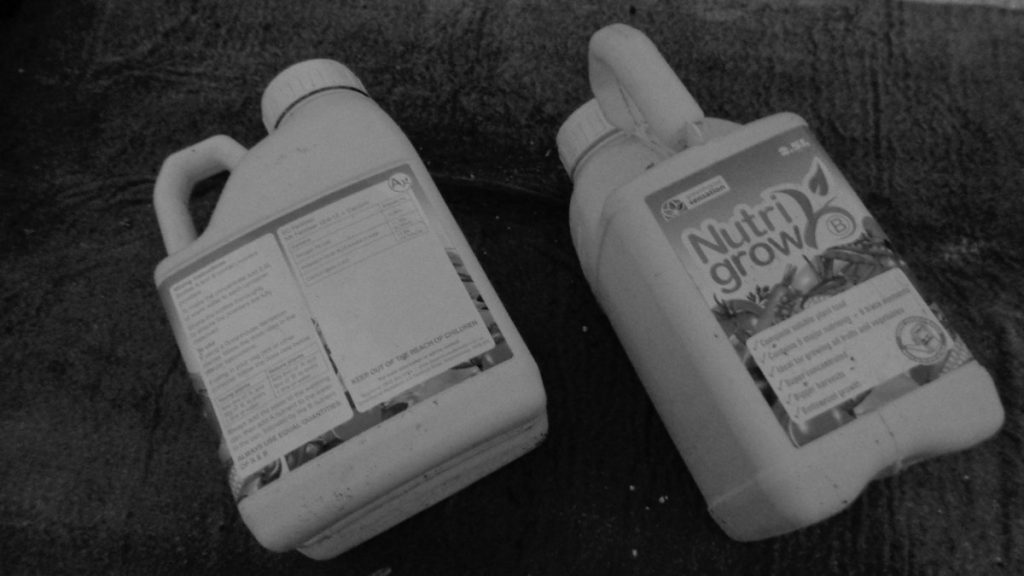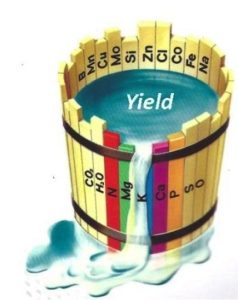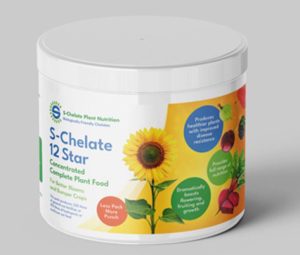I’ve been seeking a replacement for Nutrigrow fertiliser since I found out that Greenhouse Sensations had ceased trading. Judging by comments on my post about Greenhouse Sensations about replacing Nutrigrow and emails received, I’m one of many. Now I have found a superior product.
Over the last weeks I’ve had discussions with chemist Barry Langdon from S-Chelate fertilisers. Initially I asked him about formulating an equivalent fertiliser to Nutrigrow but it turns out that S-Chelate 12 Star will substitute for Nutrigrow. In fact it has some major advantages over Nutrigrow, so I’m replacing Nutrigrow with a superior product at a competitive price.
2 Part Fertilisers (Binary Fertilisers)
Nutrigrow and similar fertilisers come in two parts. The reason for this is that complete fertilisers need to contain calcium. Calcium is a vital secondary nutrient, essential for plant growth and development. It improves the absorption of other nutrients by the roots and the delivery of nutrients from the roots to the rest of the plant. Without sufficient calcium growth is, at best stunted. Tomatoes will suffer blossom end rot without enough calcium.
When soluble calcium salts are mixed in solution with soluble phosphorus salts they react together and produce an insoluble Calcium salt. This insoluble Calcium salt is not available to the plant.
The longer the calcium and phosphorus are mixed, the more of the soluble calcium is converted to the insoluble form. This limits the value of the fertiliser as the bioavailable soluble calcium level decreases over time.
Nutrigrow Replacement Fertiliser
S-Chelate 12 Star solves this problem by solubilising the Calcium with S-Chelate technology hence you only need one product which contains all of the Macro, Secondary and Micronutrients and it stays soluble when you dissolve it for more than long enough for the plant to absorb it. S-Chelate 12 Star is not just a Nutrigrow replacement fertiliser, it’s an improvement.
Trace Elements & Micro-Nutrients in S-Chelate and Nutrigrow
As well as the main nutrients of Nitrogen, Phosphorus and Potassium (NPK) and the calcium covered above, like Nutrigrow, S-Chelate contains seven other key micronutrients plus S-Chelate also contains sulphur:
Magnesium Oxide
Magnesium is required for healthy leaves and for plants to harness energy from the sun (photosynthesis). It is also required for protein synthesis and contributes to the activation of many plant enzymes needed for growth
Boron
Boron is an essential plant nutrient that plays a key role in a diverse range of plant functions including cell wall formation and stability, maintenance of structural and functional integrity of biological membranes, movement of sugar or energy into growing parts of plants, and pollination and seed set. One tell tale symptom of boron deficiency in the soil is that cauliflowers produce brown curds, not to be confused with sunlight discoloured curds.
Copper
Copper plays a part in several enzyme processes and is key to the formation of chlorophyll. It activates some enzymes in plants which are involved in lignin synthesis and it is essential in several enzyme systems. Copper is also required in the process of photosynthesis. It is essential in plant respiration and assists in plant metabolism of carbohydrates and proteins
Iron
Iron has a number of important functions in plants, not least in the formation of chlorophyll which is how plants utilise sunlight for energy. One obvious symptom of iron deficiency is chlorosis, yellowing of the leaves.
In soil rich in organic matter a number of biochemicals assist the plants in taking up iron by acting as chelating agents. S-Chelate contains chelated iron.
Manganese
Manganese is needed for photosynthesis to take place. Without photosynthesis the plant will not grow. It is used by the plant to utilise nitrogen, the main element for leaf production. Manganese also helps the plant resist root pathogens and to produce pollen.
Molybdenum
Although molybdenum is only required in very small quantities but it is vital. Molybdenum is necessary for the conversion of nitrogen into a usable form by the plant. One cause of molybdenum deficiency is over-feeding plants with nitrogen. The plants use up all the available molybdenum to utilise the nitrogen feed.
Molybdenum is the only micronutrient whose availability decreases as the pH of the growing medium decreases. S-Chelate 12 Star provides enough molybdenum that this isn’t a problem.
Zinc
Zinc is crucial to many functions and systems in plants. It is used in the formation of chlorophyll along with the chemical process of converting starches to sugar and growth regulation. Zinc also helps plant tissue withstand cold temperatures, useful in the changeable British climate.
Sulphur
Unlike Nutrigrow, S-Chelate also contains Sulphur which is essential for the growth and development of all crops. It has some key functions in plants such as formation of chlorophyll that permits photosynthesis through which plants produce starch, sugars, oils, fats, vitamins and other compounds. Sulphur is also essential in forming proteins, enzymes, vitamins, and chlorophyll in plants.
Why Micro-Nutrients are needed in these fertilisers
With fertilisers like Nutrigrow and S-Chelate being used for fertigation in wicking pot systems like Quadgrows, Chilligrows and Hozelock Growbag Waterer the amount of growing medium is quite limited in relation to the plants. This means that some micro-nutrients can run out quite early in the growing season.
With hydroponic systems where the only source of micro-nutrients is the fertiliser, a top quality fertiliser providing the needed micro-nutrients is even more import.
Liebig’s Law of the Minimum
 Liebig’s Law of the Minimum is the principle that growth is limited by the scarcest resource. It doesn’t matter if the plant has a lot of nitrogen to fuel growth if it doesn’t have sufficient manganese to utilise it. To put it another way, a car with a full tank of petrol but no oil in the engine won’t get far!
Liebig’s Law of the Minimum is the principle that growth is limited by the scarcest resource. It doesn’t matter if the plant has a lot of nitrogen to fuel growth if it doesn’t have sufficient manganese to utilise it. To put it another way, a car with a full tank of petrol but no oil in the engine won’t get far!
It’s important to keep in mind that an element may be in the soil or nutrient solution but unusable by the plant. This is where chelation to ensure bioavailability across a range of conditions is so valuable.
This principle is best illustrated by Leibig’s Barrel where the level of water cannot rise above the lowest stave
Chelation
Chelation is a chemical process that stabilises and makes elements remain in solution and stay available for uptake by the plants. The usual method of chelating chemicals does have some problems with accumulating in the environment.
The method used by S-Chelate solves this accumulation problem. The chelated micro-nutrients in 12 Star are actually organically approved by the soil association. Because of the basic NPK fertiliser included in 12 Star cannot be certified for organic farming.
Using S-Chelate as a substitute for Nutrigrow
 Once again, S-Chelate is superior to Nutrigrow. The Nutrigrow fertiliser involved mixing 250 grams of pack A with 2.5 litres of water and then the same with pack B. When mixing to use in Quadrows etc. Part A is mixed with water at a rate of 6ml per litre and then 6ml per litre of Part B added.
Once again, S-Chelate is superior to Nutrigrow. The Nutrigrow fertiliser involved mixing 250 grams of pack A with 2.5 litres of water and then the same with pack B. When mixing to use in Quadrows etc. Part A is mixed with water at a rate of 6ml per litre and then 6ml per litre of Part B added.
In contrast, S-Chelate 12 Star is simple and does away with pre-mixing. A 5ml scoop is sufficient to make a watering can (4.5 litres) of full strength nutrient solution.
For young plants or crops like salads where you would have used half strength Nutrigrow solution with 12 Star the easiest method is to make up a solution in a jug or bottle with a 5ml scoopful dissolved in it. Then add half the solution to the watering can and top up to 4.5 ltrs reserving the remainder for the next can full.
Replacing Nutrigrow
Nutrigrow has been an essential for my greenhouse growing since I started using the excellent Quadgrow system. I was concerned about replacing Nutrigrow when supplies stopped. Now I’m happy that I’ve got a superior product, easier to use and very affordable with S-Chelate 12 Star.




Where can I buy the Nutrigrow replacement
I’ve now found a replacement for Nutrigrow that is simple to use and I think more effective. S-Chelate 12 Star It has a slightly different formula, containing sulphur in addition to the same micronutrients as Nutrigrow. I’ve posted a long article going through the technical details and usage details here: Nutrigrow Replacement Fertiliser
Thanks for this information. Is this product suitable for organic vegetable growing?
Hi Amanda, S-Chelate 12 Star is not approved for organic cultivation as it contains NPK artificial fertiliser. However S-Chelat-O Cultiv-8 is as it only supplies the trace elements and the chelation is (like 12 Star) non-bioaccumulative and biofriendly. Cultiv-8 will cover any deficiencies apart from the basic NPK level which should be supplied naturally via manures, composts or approved amendments like chicken manure pellets.
Thanks so much for your prompt and informative reply. Much appreciated.
I grow my tomatoes, aubergines, peppers and cucumbers in my two long beds each side of the central path so have a fairly good depth of soil which gets refreshed each year and has added mushroom compost. Would this S-Chelate 12 star be better than something like a tomato liquid fertiliser? Thanks, Geoff Padmore
Hi Geoff, difficult to say for sure. If your borders are low on a trace element, particularly calcium, then S-Chelate will really outperform standard tomato fertilisers. If not, then unlikely to make a noticeable difference. If I was you, I’d have a tub to hand and if the tomatoes etc. looked a little sickly at any point then feed weekly with S-Chelate and see if that does the trick.
Kept tightly sealed and preferably in a cool location, it will easily keep for 2 years.
JOHN can I do away with quadgrow system now and go back to pots and trays for Tom’s and the like as I get about 12 inch more height. I will use the pots and get rid of the water container. The replacement fertiliser is a lot less complicated.
Thanks
Brian
Hi Brian, yes. Just feed weekly at double the fertigation strength (2x5ml per 4.5ltr can).
Thanks for the help John
Brian
This is my third year of using it since you first recommended it John, in a polycrub.
Initially I used it for cucumbers and peppers but because the results were so good used it on tomatoes alternate weeks with a liquid tomato fertiliser. I had no tomato end rot or blight.
I overwintered herbs in pots in the crub and they are now looking poorly to say the least.
Wonder if it will work the same magic or be too strong, especially for rosemary and thyme. What do you think?
Many thanks
Fiona
Hi Fiona – herbs generally don’t need too much feed so I would use half strength fertiliser. S-Chelate 12 Star at one scoop per 4.5ltr watering can should be sufficient. It will cover all the bases.
Thanks for your investigative work John. I hope they’re giving you the S-Chelate 12 Star for free as a brand ambassador! I will be ordering some shortly
Hi are you adding this to the planter as done with Nutrigrow or you adding it to the pot with the compost, thanks
To the planter – use at 1 scoop per can for Quadgrows etc.